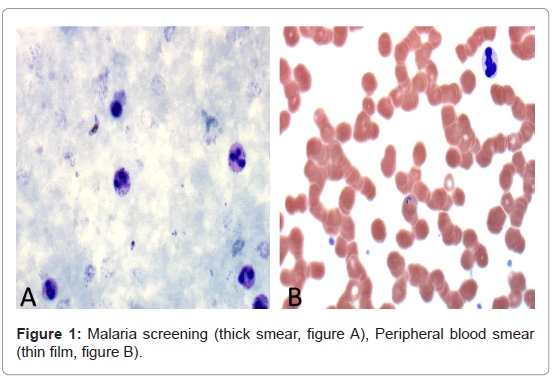Plasmodium falciparum Infection In Six Months Old Baby
Received: 25-Nov-2020 / Accepted Date: 09-Dec-2020 / Published Date: 16-Dec-2020 DOI: 10.4172/2332-0877.1000442
About The Case
Malaria infection is caused by plasmodium species carried by female anopheles mosquito. There are five plasmodium species are known to cause malaria in human (P. Falciparum, P. vivax, P. ovale, P. malariae and P. knowlesi) [1,2]. The estimated deaths form malaria in 2018 is 405000 worldwide of which the most affected age group is children aged under 5 years representing more than two third of the total deaths (67%, 2,72,000 deaths) of all malaria deaths worldwide [3]. Plasmodium falciparum known to cause severe disease with high mortality [4].
A six-month-old boy, not known to have any medical illness before presented to the emergency department with a history of persistent fever, poor appetite, decreased activity, and a history of one episode of generalized tonic-clonic convulsion for few minutes that aborted spontaneously. On examination, he was pale, mildly icteric, and irritated without neurological deficit. Chest and CVS were unremarkable. The abdomen was soft, lax but mildly distended with Hepatosplenomegaly (liver is 3 cm-4 cm, and spleen 6 cm below left costal margin). Investigations show Hb 7.5g/dl, WBC 17 x 10 ^3/ul, Platelet 61 x 10 ^3/ul, reticulocyte 3%, and LDH 380IU/L. ESR 105 mm/H, ALT 538IU/L, AST 862IU/L, bilirubin 400 μmol/L and direct bilirubin 198 μmol/L. Lumbar puncture shows clear fluid, WBC nil, RBC nil, glucose 3.4 mmol/l, and protein 0.13 g/l.
• The COVID-19 swab was negative.
Blood, urine, stool, gram stain, and CSF cultures were negative. Urine analysis was normal. Other infection screening, including Hepatitis, HIV, CMV, EBV, dengue, HSV, and parvovirus, were negative. Hb electrophoresis is normal for age. G6PD and coagulation profile were within an acceptable range [5].
CT brain was unremarkable.
• The malaria rapid test was positive.
Malaria screening (thick smear, A) Figure 1 shows plasmodium ring forms and rare Banana-shaped gametocytes.
Peripheral blood smear (thin film, B) confirmed thrombocytopenia with rare large and giant platelets. Normocytic anaemia with mild anisopoikilocytosis, few crenated red cells, occasional fragmented red cells (<1%), mild polychromasia, and rare NRBCs. Neutrophils are slightly increased with mild reactive changes. Few atypical reactive looking lymphocytes are seen. Few RBCs with Plasmodium falciparum rings inclusion with rare Banana shaped gametocytes are identified. Parasitaemia level is 2.1%.This child was admitted to the intensive care unit and given IV fluids. He received two packed RBCs and broad- spectrum antibiotics for a few days. The patient was successfully treated with artesunate and fansidar, and he dramatically improved within a few days with slight regression in organomegaly. Repeated peripheral blood smear revealed no parasite. The patient was discharged in good condition with no residual complication. Malarial infection is more frequently seen in adult, and it is not commonly seen in this age group. However, in endemic areas, it is one of the differential diagnoses of children presented with such clinical symptoms.
Conclusion
Plasmodium infection, especially P. Falciparum infection, Can lead to severe disease and can be fatal if left untreated, especially in high-risk populations; therefore, early diagnosis and starting antimalarial drugs can be of significant impact on the patient condition.
References
- Saad H Abdalla, Geoffrey Pasvol (2004) Malaria: A hematological perspective 4th ed. imperial college press, 57 Shelton Street, Covent Garden, London WC2H 9HE.
- World Health Organization (2015) Guidelines for the Treatment of Malaria. 3rd ed. Geneva: PMID: 26020088.
- World Health Organization (‎2019)‎ World malaria report 2019. World Health Organization.
- Greenwood BM, Bojang K, Whitty CJ, Targett GA (2005) Malaria. Lancet 365:1487-1498.
- World Health Organization (2015) Guidelines for the Treatment of Malaria. (3rd edn) Geneva.
Citation: Alneami Q (2020) Plasmodium falciparum Infection in Six Months Old Baby J Infect Dis Ther 8: 442. DOI: 10.4172/2332-0877.1000442
Copyright: © 2020 Alneami Q. This is an open-access article distributed under the terms of the Creative Commons Attribution License, which permits unrestricted use, distribution, and reproduction in any medium, provided the original author and source are credited.
Share This Article
Recommended Journals
Open Access Journals
Article Tools
Article Usage
- Total views: 1878
- [From(publication date): 0-2020 - Nov 21, 2024]
- Breakdown by view type
- HTML page views: 1313
- PDF downloads: 565

